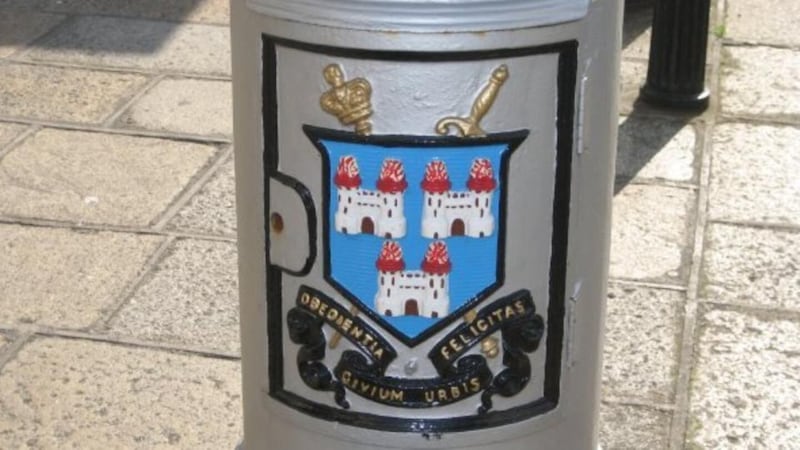A problem with the “three sieges of Dublin” theory as the true meaning of the city’s burning castles emblem (Diary, July 3rd), Des Gunning reminds me, is that there was a fourth siege in the time frame specified. And a conspicuously fiery one too.
When an army led by Robert and Edward the Bruce marched on Dublin in February 1317, the panicked defenders did what Moscow would do 500 years later, in the face of Napoleon: burn their own city.
Or at least they burned the suburbs, such as they were then, including the neighbourhood of St Thomas, where Thomas Street is now.
They also dismantled the Dominican priory on the north of the Liffey and the church of St Mary’s del Dam (from which the modern and mispronounced Dame Street gets its name) and used the materials to strengthen the walls.
READ MORE
The sacrifices worked. Camped at Castleknock, the Bruces had nowhere nearer the castle to occupy and, pre-empted by Dublin’s self-inflicted siege, called off plans for their own.
So as Des points out, the city arms would need a fourth burning castle to commemorate the Bruces’ contribution to history. But that would be in contravention of the mystical rule of threes.
Unless we were to lop off the 1649 siege from the trio originally proposed in Senan Molony’s scheme and make the sequence 1171, 1317, and 1534 instead. That might work.

***
I see that an ancient – or ancient-sounding anyway – part of Dublin is up for sale, although you wouldn’t know it from the property ads.
Colliers are seeking €4.4 million for two adjoining houses, 12 and 13 Fitzwilliam Place, which they describe as “bright spacious office accommodation that retains many original period features including attractive cornicing, ornate fireplaces, and ceiling roses throughout”.
The blurb adds that the main buildings “are entirely separate save for the basement levels, which are interlinked” and one of which (no 12) is occupied “by the prestigious law firm Reddy Charlton”.
[ All fired up – Frank McNally on the questionable wisdom of Dublin’s logoOpens in new window ]
But it’s possible that the occupants also include a few literary and artistic ghosts.
In the late 1940s this was the location of the semi-legendary “Catacombs”, a late-night drinking and party venue described by one former habitué as being a 20th century version of “the Hellfire Club”.
Here is JP Donleavy, from his 1955 novel The Gingerman (1955), giving the property a different kind of write-up: “They pushed through an iron gate and down the black steep steps. Tony Malarkey, host, grinning, a pleased bull smelling the hot rump of a cow in heat, counting the parcels of stout. Eyes on the corks. Through a scullery there was a huge kitchen ...
“The air filled with the popping of corks. A smell of damp walls and cavities. A feeling of long corridors and hidden rooms, tunnels in the earth, black pits and wine cellars filled with mouldy mattresses. A bulb burning in the center of the kitchen. The floor, stained, red tiles. Whitewashed walls and scabby buttresses crossing the ceiling. And more people bursting in the door laden with bags of stout.”
Later in the novel, Donleavy also gives a flavour of the clientele in full spate: “The room thick with smoke. Bobbing skulls ... Barney singing, swaying on the tiles. Sweating. Clocklan had left the blonde to drag the little jeweler to the black rear of the catacombs for further discipline. Busting him in the head with the bottom of his fist. I tell you, the place is writhing, simply writhing. Malarkey shouting he was high bloody king and if they didn’t all cheer up he would break their faces. Clocklan’s woman got up on the table to dance. Wiggling wang, she called it. And Percy came back with a grand grin which he wiped when he saw his woman on the table and he said she was a disgusting tramp and didn’t she have any pride at all to be dancing like that in front of a whole bunch of people.”
***
If it’s only the building they once occupied that’s on sale for now, the spirit of the former Catacombs is itself undergoing refurbishment and will be the subject of a new stage play later this autumn.
The latest production of the Dublin Shakespeare Society, it will tell the story of the venue from the viewpoint of the original owner, Dickie Wyman, who relocated to Dublin from England during the second World War, after his boyfriend was killed in action and to avoid being drafted himself.
Founded in 1907, the society is the oldest amateur theatre company in Ireland and, despite its name, performs a repertoire far beyond that of the eponymous Bard.
Remarkably, it has lived to see a situation whereby a man called Shakespeare (city council chief executive Richard) is now running Dublin, although the society would hardly claim credit for that.
In any case, the play is due to open in October. But the original location being otherwise occupied these days, the Catacombs as reimagined by the DSS will be transposed to another celebrated basement: the society’s headquarters at 36 Parnell Square, aka the Teachers Club.

















